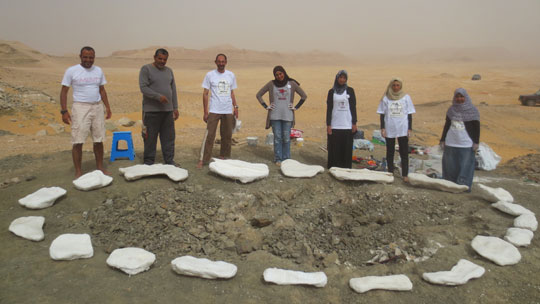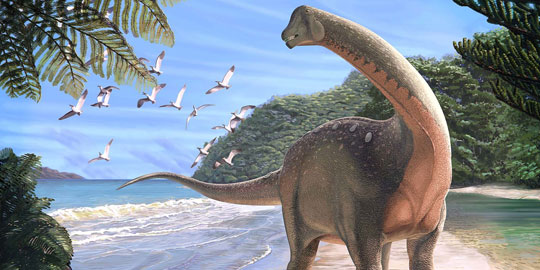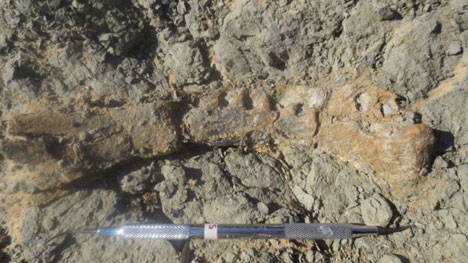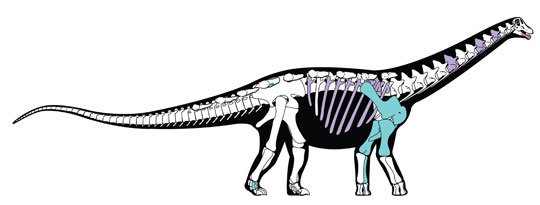Mansourasaurus shahinae the Rosetta Stone of the Dinosauria
Mansourasaurus shahinae the Rosetta Stone of the Dinosauria
The Rosetta Stone, with its three different languages carved into the rock, provided the breakthrough for archaeologists, enabling them to decipher Egyptian hieroglyphic writing. A new dinosaur discovery, which just like the Rosetta Stone heralds from Egypt, is helping palaeontologists to decipher the relationship between Late Cretaceous African dinosaurs and their counterparts elsewhere in the world. The dinosaur has been named Mansourasaurus shahinae and up until now, no reasonably complete dinosaur skeleton from Upper Cretaceous strata in continental Africa had ever been found.
An Illustration of the Newly Described Titanosaur Mansourasaurus shahinae
Picture credit: Andrew Mcafee (Carnegie Museum of Natural History)
Helping to Characterise the Late Cretaceous Dinosaur Fauna of Africa
As titanosaurs go, Mansourasaurus is not a ground-shaker in terms of its size, it was approximately ten metres in length and was perhaps as heavy as Africa’s largest land animal today, an African elephant (Loxodonta). It was not fully grown (bones not entirely fused), but it would not have reached the size of leviathans such as Paralititan (P. stromeri), which roamed North Africa some fifteen million years earlier.
However, its discovery is seismic as it permits palaeontologists to better understand the evolution of Late Cretaceous African dinosaurs and their taxonomic relationship to other dinosaurs that lived elsewhere in the world during the last few million years of the Mesozoic.
The Fossilised Jawbone of M. shahinae Photographed at the Dig Site
Picture credit: Mansoura University
Mansourasaurus shahinae – Conflicting Theories and Conflicting Ideas
Very few Late Cretaceous African dinosaurs have been described. Fossil finds from Upper Cretaceous strata in this part of the world are very rare, what fossils have been found are extremely fragmentary and don’t reveal much information about the sort of dinosaurs that these seldom found bones represent. Did the dinosaurs living on the African continent in the Late Cretaceous evolve into a distinct biota or were they closely related to other types of dinosaur living on other landmasses?
In addition, if the Late Cretaceous African dinosaurs were closely related to other dinosaurs living elsewhere, were they more closely related to those dinosaurs known from South America, Europe, Asia or even Madagascar?
A remarkable fossil discovery from strata estimated to be around 80 million-years-old (Campanian faunal stage of the Late Cretaceous), will help scientists to answer some of these questions. Just like the famous Rosetta Stone, these petrified dinosaur bones will help scientists to decipher, at least in part, the evolutionary relationships of African titanosaurs.
Phylogentic Assessment of Titanosaurs
Field work at the Dakhla Oasis of the Egyptian Sahara, led by Dr Hesham Sallam (Mansoura University), in 2013, led to the discovery of the partial remains of a sauropod dinosaur, one that was identified as a member of the Titanosauria clade – a group of long-necked, herbivorous dinosaurs that were geographically widespread during the Cretaceous. By studying these bones, palaeontologists were able to work out which other titanosaurs were closely related to Mansourasaurus. The phylogenetic assessment published along with the rest of the paper in the journal Nature, Ecology & Evolution, indicates that M. shahinae is related to titanosaurs from southern Europe and eastern Asia.
A Reconstruction of the Skeleton of Mansourasaurus
Picture credit: Andrew Mcafee (Carnegie Museum of Natural History)
The Dinosaurian Palaeobiogeography of Gondwanan Landmasses
The fossils come from rocks that make up the Quseir Formation, these sediments were laid down in a warm, humid, tropical environment. A low-lying, verdant floodplain that was criss-crossed by large rivers and numerous lakes. The picture (above) reveals how much of the skeleton has been excavated since the initial fossil discovery around five years ago. Fragments of the skull and the lower jawbone have been recovered along with cervical vertebrae (neck bones), ribs, elements from the front limbs and a portion of the hind foot. Numerous bony scales are associated with these bones, this suggests that Mansaurasaurus, like many other titanosaurs, was covered in osteoderms.
Members of the Field Team from Mansoura University Pose Next to the Jacketed Fossil Bones

Picture credit: Mansoura University
Piecing Together the Geographical and Faunal Links Between Late Cretaceous Africa and Other Landmasses
The discovery of Mansourasaurus will help scientists to piece together the geographical and biological links between the Late Cretaceous of Africa and other continents. The fossil bones can be used just like the Rosetta Stone, to compare and contrast with known fossil finds and future titanosaurid fossil discoveries.
The research team conclude that as Mansourasaurus was closely related to Eurasian titanosaurs, this indicates that these dinosaurs spread between Europe, Asia and north Africa after the tectonic separation of Africa from the landmass that was to form the continent of South America. In essence, Mansourasaurus hints at a north African dinosaur assemblage that mirrors the sort of dinosaur fauna known from the Late Cretaceous of Europe and Asia. The team’s findings support the idea that land bridges existed between Africa and other parts of the world, allowing this faunal interchange. The theory that the African mainland was completely isolated in the latter years of the Cretaceous has been undermined.
A spokesperson from Everything Dinosaur stated:
“This is a very significant fossil discovery. It marks a new chapter in our understanding of the evolution and spread of Late Cretaceous titanosaurs, it might even herald a new chapter in the history of vertebrate palaeontology in northern Africa, as we are confident that more dinosaur specimens are still out there in the Egyptian Western Desert awaiting discovery.”
The scientific paper: “New Egyptian Sauropod Reveals Late Cretaceous Dinosaur Dispersal between Europe and Africa” by Hesham M. Sallam, Eric Gorscak, Patrick M. O’Connor, Iman A. El-Dawoudi, Sanaa El-Sayed, Sara Saber, Mahmoud A. Kora, Joseph J. W. Sertich, Erik R. Seiffert & Matthew C. Lamanna published in the journal Nature, Ecology & Evolution.
Visit the Everything Dinosaur website: Everything Dinosaur.




